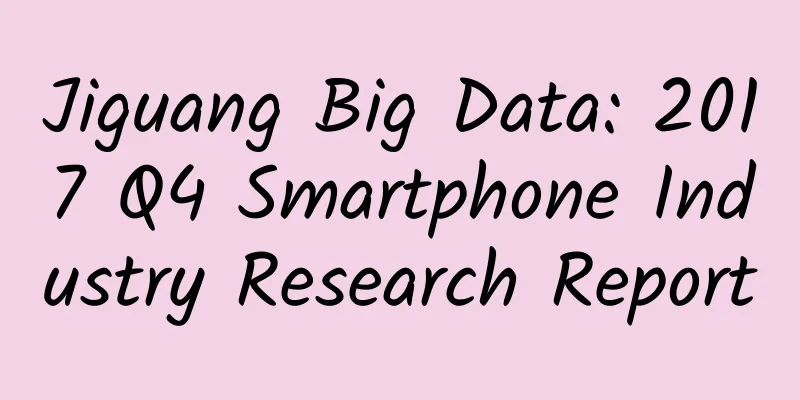Jiguang Big Data: 2017 Q4 Smartphone Industry Research Report

|
In the fourth quarter of 2017, the smartphone industry continued to be full of excitement. The iPhone X released in September boosted iPhone sales. The domestic Android camp was steady and steady, with Huawei and Xiaomi both increasing their sales share. Vivo surpassed OPPO for the second time this year, and the two sides ended the four quarters in a 2-2 tie. Jiguang Big Data released the "2017 Q4 Smartphone Industry Research Report", which depicted the final battle of the smartphone industry in 2017 from multiple angles such as retention rate, sales share, user loyalty, and user portraits. Aurora Viewpoint
Aurora Viewpoint
1. Analysis of Smartphone Ownership Rate Domestic mainstream mobile phone brand ownership rate in Q4 2017 One in five Chinese mobile Internet users has an iPhone
Q4 Mainstream mobile phone brand ownership trends Thanks to the promotion of new products, iPhone Q4 retention rate exceeded 20%
Q4 City-level distribution of major mobile phone brands New first-tier cities contribute about 20% of users to major mobile phone brands
Q4 Mainstream Mobile Phone Brand and Model Distribution OPPO is the Android brand that relies most on star models, followed by vivo iPhone model distribution trend As of December 2017, the iPhone 6, which was released in September 2014, still has the largest share of iPhone users.
2. Analysis of Smartphone Sales Domestic mobile phone brand sales share in Q4 2017 More than one in five mobile phones sold in Q4 was a Huawei phone
Q4 Mainstream mobile phone brands sales share change trend OV sales share is catching up with each other, vivo Q4 is temporarily in the lead
Sales volume and price distribution of mainstream mobile phone brands in Q4 Thousand-yuan phones accounted for nearly 60% of Xiaomi's sales in Q4
Top 10 mobile phone models sold in Q4 Four models of vivo entered the top 10 mobile phone models in Q4 sales
3. Analysis of user loyalty of mainstream mobile phone brands User loyalty of mainstream mobile phone brands - iPhone iPhone user loyalty reaches all-time high this quarter
User loyalty of mainstream mobile phone brands - Huawei Huawei user loyalty remains stable, same as in Q3
User loyalty of mainstream mobile phone brands - OPPO OPPO user loyalty showed a slight decline, and the number of users who chose its sister brand vivo for replacement increased by 1.9% compared with Q3.
User loyalty of mainstream mobile phone brands - vivo Vivo user loyalty reaches its highest point in five quarters
User loyalty of mainstream mobile phone brands - Xiaomi Xiaomi user loyalty is recovering, and OV's influence on Xiaomi is weakening
4. User portraits of mainstream Android phone brands User portrait of mainstream Android phone brands - Huawei Huawei users: 65.6% male, love watching movies, and make friends through sports and bodybuilding
User portrait of mainstream Android phone brands - OPPO OPPO users: more female users, nearly 70% of users are under 30 years old
User portrait of mainstream Android phone brands - vivo Vivo users: Most of them are male, and their age structure is younger than OPPO
User portrait of mainstream Android phone brands - Xiaomi Xiaomi users: Perhaps the most popular mobile phone brand among young men with artistic tastes
5. Mobile App Installation Status Overview of high-end, medium-end and low-end mobile phone application installation On average, 51.2 apps are installed on each high-end computer
High, medium and low-end mobile phone preference index There are obvious differences in the preferences of high-end, medium-end and low-end mobile phone users for mobile apps
Mainstream Android Phone Preference Index Kuaishou is favored by OV users
6. Research on Operator Apps Market share of the three major operators 73.9% of Chinese mobile Internet users are mobile users
Market share of the three major operators among mainstream mobile phone brands Mobile's market share in OV is higher than the overall market level
Market share trends of the three major operators In the past five quarters, the market share of the three major operators has not changed significantly, and China Mobile has always maintained its lead. Penetration rate of mobile phone business hall apps of operators in mainstream Android phone brands China Unicom's mobile phone business halls have a higher penetration rate in Huawei and Xiaomi than the other two.
Penetration trend of mobile phone business hall apps of operators in mainstream Android phone brands The national app penetration rates of the three major operators have increased overall over the past year, with China Unicom seeing the most significant increase.
Report Description 1. Data Source Aurora Big Data is derived from the industry data collection of Aurora Cloud Service Platform and the long-term monitoring of various mobile applications by Aurora iAPP Platform, combined with data mining and statistical analysis conducted by large sample algorithms. 2. Data cycle Overall reporting period: October 2016 - December 2017 Please refer to the notes on each page for specific data indicators 3. Data indicator description Retention rate: The total number of active mobile phones in the country calculated based on the number of active mobile phones that have reported data at least once monitored by Jiguang Big Data within a specified time period Sales volume: National mobile phone sales volume estimated based on the increase in the number of mobile phones monitored by Jiguang Big Data within a specified time period User loyalty: The proportion of users of a certain mobile phone brand who choose the original brand when changing their mobile phones. The higher the proportion, the higher the user loyalty. 4. Legal Notice The data information provided by Jiguang Big Data is estimated and analyzed based on large sample data sampling, small sample surveys, data model predictions and other research methods. Due to the limitations of the methods themselves, the data information estimated and analyzed by Jiguang Big Data based on the above methods is for reference only. Jiguang Big Data does not make any guarantees about the accuracy, completeness, applicability and non-infringement of the above data information. The legal consequences of any actions taken by any organization or individual based on the above data information have nothing to do with Jiguang Big Data, and any disputes or legal liabilities arising therefrom shall be borne by the actor. 5. Other information in the report Aurora Data Research Institute will use its big data capabilities to conduct more detailed analysis and interpretation and business insights in various fields. Please stay tuned. The PDF version will be shared to the 199IT exchange group. 199IT thanks you for your support! |
<<: Streamlabs: YouTube Live viewership reached 24% in Q1 2019
>>: App Annie: 2017 Japan and South Korea monthly active users, downloads and revenue rankings
Recommend
What to do if a pregnant woman has a cold and cough
Cold and cough are very common diseases. For norm...
Introducing the effects and functions of Xiaoyao Pills for women
People who have suffered from breast diseases sho...
Can I get pregnant if I have sex right after my period?
Some women can't wait to have sex with their ...
How to eliminate foot edema during pregnancy
Edema during pregnancy is a normal phenomenon, wh...
What are the contraceptive methods for women?
For most women, they are troubled by not being ab...
Is it normal for a girl to have irregular menstruation?
For every parent, it is necessary to take care of...
What causes acne in the vagina?
The vagina is the most private space of women. In...
Why did Fang Sijin let her husband and wife look at houses separately? The reason why Fang Sijin let Gong Beibei look at houses alone
In the second episode of An Jia, Fang Sijin repea...
Symptoms of high estrogen levels
The reason for excessive androgen secretion in wo...
Can pregnant women drink lemon water? Expectant mothers must know
As we all know, there are many dietary taboos for...
How can women with flat breasts be treated?
Breast size is a very important indicator for wom...
I'm 14 years old, why haven't I had my period yet?
After girls reach puberty, their bodies will begi...
What medicine is good to take after childbirth?
As the saying goes, food is the most important th...
What is the reasonable schedule for myopia surgery?
Myopia surgery always has an imaginary time cost ...
What foods should women eat to maintain beauty?
Women are born to love beauty, so they pay specia...









